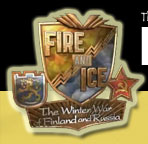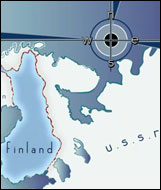

The peace terms that ended the Winter War in March 1940 were quite harsh to Finland. Not only was there the great loss of life (25,227 Finnish soldiers killed) but over 22,000 square miles of Finnish land was turned over to the USSR. This was a bit over 10 percent of the total territory of Finland. The Finns lost the entire Karelian Isthmus which included Finland’s second largest city Viipuri. The militarily important section of Hanko was lost, as were many of the areas that had previously been fortified against possible Soviet aggression. Industries related to timber, chemicals, textiles, and various refining plants were all greatly affected by the loss of Finnish territory. The loss of important port areas would also have lasting effects on the Finnish way of life. Over 400,000 Finns were displaced from their homes. There were also Soviet demands for war reparations which the Finns would struggle to meet.
Finland was also faced with major security issues that needed to be addressed. Before the Winter War, Finland had hoped that the Western Powers would intervene in case of Soviet attack but this hope was lost when the West did next to nothing when the Soviets invaded. Finland saw itself as alone and isolated from the rest of the world. The military was in dire need of resupply and new military equipment. While the Finns did receive Winter War aid, most of equipment did not arrive until the fighting was over and what the Finns did receive was, in many cases, equipment that was outdated or in poor condition. Also their border defenses were now in ruin and new defensive networks needed to be constructed. The relationship with the Soviet Union was still very uneasy and the Finnish military had to be prepared in case these relations took another turn for the worse.
During the negotiations of the peace treaty that ended the Winter War, Finland was approached by Sweden about forming a Nordic Defense Alliance (Finland, Sweden and Norway) that would help to ensure Finnish security. After the peace treaty was signed this idea was expanded upon and Sweden formally approached Finland about such an alliance. This was quickly protested by the Soviet Union and, under heavy pressure from Moscow, the Finns rejected the Swedish proposal. This action again lead to Finland feeling further isolated from the rest of the world.
In April 1940, Denmark was occupied by the Germans and the Germans invaded Norway. In June the Baltic States of Estonia, Latvia and Lithuania were seized by the Soviets and their governments removed. These actions further worried the Finns as it seemed as if Stalin and Hitler were to have free reign on any smaller nation in Europe. The Finns greatly feared that Stalin’s intentions on Finland were the same as seen in the Baltic States with the aim of making Finland a part of the Soviet Union. June 1940 also saw the shooting down of a Finnish civilian aircraft over the Finnish Gulf (Soviet fighters) as well as Soviet Minister Molotov expressing interest in the nickel mines at Petsamo. These nickel mines were also of great interest to Great Britain and Germany. Lastly at the end of June, the Soviets demanded the island of Åland be demilitarized with Soviet oversight on this program. In July, the Soviets requested that limits to the numbers of Soviet troops traveling on the railroads to the Hanko base be eliminated. This meant the Soviets could move an unlimited number of troops inside Finnish borders. There were other Soviet demands made, dealing with the Soviet desire to replace certain governmental leaders in Finland. Finland signed a transit agreement with the Germans which allowed transport of arms, supplies and personnel to Norway via northern Finland, which angered leaders of the Soviet Union.
In January 1941, Finnish Chief of Staff Gen. Heinrichs, while in Berlin, was informed there was the possibility of a German-Soviet war looming. The Germans quizzed Heinrichs about the Finnish Army and its strength and there were questions on Finnish terrain, roads, weather and such related topics. This information was passed on to Finnish leadership but it was still unclear as to whether there would be war between Hitler and Stalin or if this talk of war was nothing more than talk. It was not until May 20 that this became clear, as Finnish President Risto Ryti was approached by Hitler’s envoy, Karl Schnurre, who informed the President that war was likely. The Finnish president was met with a proposal which stated that if Finland was attacked by the Soviet Union, Germany would come to Finland’s aid. By May 22 this proposal had been accepted by Finland, although no formal treaty was signed.
The reason the War is known as the Continuation War in Finland is that most Finns viewed these actions as the second part of the Winter War. While there were some in Finland that wanted to take land “in mass” from the Soviets, most Finns viewed this as the chance to take back just the land that was lost in the Winter War. The Finnish and German militaries also acted on their own behalf. In most cases there were not many Finn-German joint actions. The main Finnish hopes in the outcome were one of the following:
1) Germany defeats the USSR and Finland regains the lands lost in the Winter War. Finland might also acquire more territory, but overall these gains would be rather small and were not on the minds on most Finns since the main goal was to regain what was lost.
2) Germany and the USSR become involved in a bloodbath with neither side able to win. A stalemate would work for Finland as well since Finnish troops would have already taken the land lost in the Winter War. This would force a Soviet attack to displace the Finns. If there was a stalemate, this would be hard for the Soviets to do and if a treaty ended the war, Finland felt it would be able to keep what it had regained.
3) Germany inflicts massive damage on the Soviet Union and a quick peace is made. This also would allow Finland to keep the regained land.





